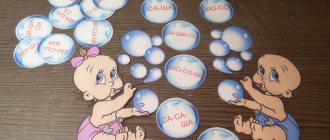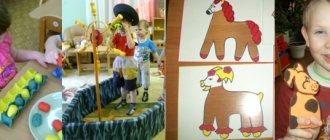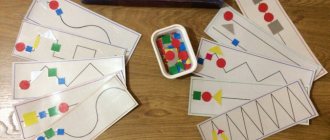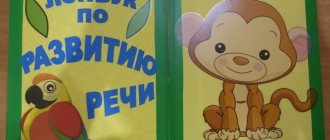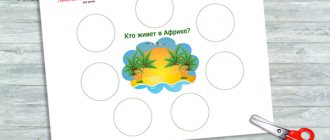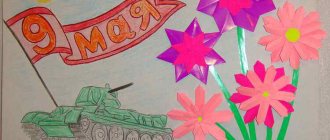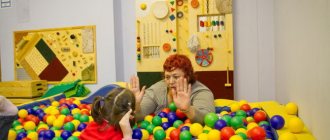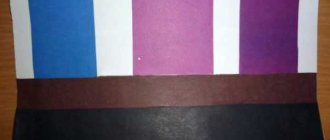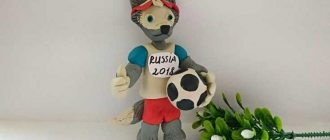Kindergarten – Corners for psychological relief
Corners of psychological relief.
Modern preschoolers are now no less busy than adults. In the process of growth and development, children have to receive and process a huge amount of information. A fragile child's psyche may not be able to withstand such a load - the child becomes capricious. That is why it is important that children in kindergarten have the opportunity to retire, recover and come to their senses.
Therefore, each group simply needs a specially organized environment, equipped with items that help relieve stress and expand the child’s opportunities for contact with other children and adults.
A corner of psychological relief is a space organized in a special way. This is a whole world in which every child feels calm, comfortable and safe. Staying in such a corner improves your psychophysical state. Dry pools are used in such corners to create a unique soft environment. The psychological corner is focused on the zone of proximal development of each child, the direction of his interests, ensuring freedom of choice and expression of will. It is also useful for creating a favorable psychological and social microclimate in the group and comfortable organization of routine moments.
Thanks to the corners of psychological relief, it became possible to control and regulate psychological, intellectual and physical stress, the well-being and mood of children, and correct them in a timely manner.
For example, the presence of upholstered furniture in the corner makes it possible to relax and reduce the level of anxiety.
The purpose of a basket with balls of multi-colored threads is to calm naughty children; also, by unwinding balls, children master self-regulation techniques and develop fine motor skills.
Important attributes of the psychological corner, the purpose of which is to teach preschoolers various ways of reconciliation after a quarrel - “reconciliation box”, “reconciliation pillow”
“rug of reconciliation” “island of reconciliation”
“Scream cups,” “anger pillow,” “bad mood piggy bank,” and “aggressive rug” help to relieve psychophysical tension and aggression, giving children an idea of how prickly they are when they are angry.
“A Corner of Solitude” is designed to solve the noble task of creating a niche of peace.
The “chair for thinking” is used so that, sitting on it for no more than 5 minutes, the child can remember the rules of behavior he has forgotten. For example, that we do not take toys away, but wait for the other child to put it back after playing, etc. The most important thing: chair should not be a punishment for children. The “chair of honor” stimulates increased self-esteem, self-confidence, and anxiety relief.
“Memories of Summer” help you find peace, relax, and relieve muscle tension.
Children feel the warmth and care of mother’s hands when they put on their “Mom’s Palms” mitten.
An album with family photos allows children to relive positive emotions and stabilize their internal state.
In the corner of psychological relief there are materials that the teacher uses in his work. This is a selection of psycho-gymnastic games aimed at developing positive self-acceptance and tolerance.
The system of work to preserve and strengthen the psychological health of children using materials from psychological relief corners leads to positive results: children quarrel less, materials from the psychological corner help anxious and shy children open up; They all collaborate with great pleasure with each other, with adults, and with the desire to play as a team.
mdou-19-ivuschk.my1.ru
Traffic light from a plastic bottle
This fabulous option is very easy. Let's turn on our imagination. We will need:
- Plastic bottle
- Brushes and paints (preferably gouache)
- Colored paper
- PVA glue
- Scissors
Work progress:
- We choose a plastic bottle, it is better to take the one with a longer neck.
- We paint it a neutral color (meaning not red, not yellow, not green). Let it dry.
- Next, we cut out circles from colored paper for the traffic light itself and details for our fairy-tale character. These are eyes, mouth, nose, ears, hands.
- The bottle is dry. Carefully glue the finished parts and, of course, the circles, making sure that the distance between them is the same.
- But our hero cannot be without hair! We also make hair from paper. Cut into thin strips and twist with scissors.
- We also make the cap out of paper. And look what happened. To fully complete our hero, we will add a rod or a road sign to the handles.
“We will drive away anger in the game”
It is no secret that in almost every kindergarten group there are children with signs of aggressive behavior. Their emotional world is often limited and not rich enough. Preventive and corrective work of a psychologist with this category of children involves the use of a variety of methods, the leading among which is play.
Play activities organized by a psychologist are carried out in three directions:
1. Working with anger. Teaching aggressive children acceptable ways to express anger.
2. Training in the skills of recognizing emotional states and controlling negative emotions.
3. Formation of the ability to empathy, trust, sympathy, empathy; harmonization of relationships in communication with children and adults.
Psychologists working with children's aggressiveness use play aids such as pillows, rugs, and bags to help the child respond to negative emotions. A variety of games are offered in the literature, for example, “The Leaning Tower” (N. Kryazheva), “Release of Anger” (K. Rudestam), etc.
In the games proposed by the author, learning game actions begins with reading a poem. Then the presenter demonstrates these actions with the help of a manual, and also demonstrates the feelings and emotions experienced.
The games are developed taking into account the above areas of gaming activity and are used to accompany children with aggressive behavior.
“Go away, anger!”
Game "Magic pillows"
Goal: responding to negative emotions, removing aggressiveness.
Age: 4–7 years.
Equipment: simple pillow, “pillow of anger”, “pillow of goodness”.
Game description
The “anger pillow,” on which aggression will be vented, is placed in front of the child on a large soft pillow or sports mat. The psychologist (or teacher) reads the poem, demonstrating playful actions, then invites the child to repeat them: hitting the “pillow of anger” with relaxed fists. You can also invite your child to hit the “pillow of anger” with inflatable or wooden hammers. When striking, you can shout out words expressing feelings of anger.
"Pillow of Anger"
The fists (hammers) are knocking, They want to drive away the anger, So that the anger does not offend Neither me nor the guys!
Then the child is offered a “pillow of goodness.” You can put relaxed hands on it, you can pet it or hug it. Thus, the reacted feeling of anger changes to pleasant feelings of calm and emotional balance.
"Pillow of Goodness"
Oh, my darling, kind little pillow, calm my palms, I love to play with you!
Game "Bag of Wrath"
Goal: responding to negative emotions, removing aggressiveness.
Age: 4–7 years.
Equipment: “bag of anger.”
Game description
A psychologist (or teacher) shows the child a “bag of anger”, reads a poem, then voices negative emotions using any sounds or words. An adult invites the child to shout out the accumulated discontent, resentment, and anger into the “bag of anger”.
"Bag of Wrath"
I’ll scream anger into the bag, Sometimes I’ll growl. The anger disappears so quickly, And the resentment melts away too. I’ll deftly tie the bag and I’ll say to myself: “Oh!”
Game "Magic rugs"
Goal: responding to negative emotions, removing aggressiveness.
Age: 4–7 years.
Equipment: “mat of anger”, “mat of joy”.
Game description
The “mat of anger”, on which aggression will be taken out, is placed in front of the child.
The psychologist (or teacher) reads the poem, demonstrating playful actions, then invites the child to repeat them: stomp a negative emotion on the “mat of anger”, you can invite the child to jump. With active movements, you can shout out any words expressing feelings of anger.
"Rug of Anger"
The rug of anger is fun! Well, what if there’s no time for laughter? I’ll stamp my foot: one-two-three... The anger has flown away - look!
Then the child is offered a “mat of joy”; he can lie down on it, relax, dream about something pleasant, feel calm and emotional balance.
"Rug of Joy"
Rug of joy, hello! You give my heart light. I can lie on you, I can dream on you, relax, fly, spin. I want to be friends with you!
Comment: in the process of using unusual gaming aids in games, children realize and understand that they can free themselves from destructive emotions not in an aggressive way, but with the help of magical helpers.
"We are actors"
Goal: development of the emotional sphere, the ability to understand the emotions and feelings of game characters and other people; learning the ability to expressively convey emotional states through movements, facial expressions and gestures.
Age: 4–7 years.
Equipment: illustrations with the main emotions and feelings of the character in the poem; details of the boy Zadavaki's costumes (Snowman, Gnome, Ball).
Game description
The psychologist reads a poem, accompanying the text with illustrations showing the emotional states of the game character. Then the adult invites the children to name the emotions of the main character.
The poem is read a second time, the children convey the emotions of the game character with expressive movements, facial expressions and gestures. In the next classes, children are invited to become actors.
A child who wants to portray the main character of the poem dresses up and expressively conveys the emotions and feelings of the game character.
Comment: for children of primary and secondary preschool age, the text of one poem is used in one lesson, playing out the emotional states of one character.
For older children the task can be complicated. After getting to know all the game characters, you can offer the game “We are Actors”, where each child can play the role of the hero of any poem if he wishes.
"Tricky"
Get to know the nerd: Sometimes he is cheerful, Sometimes he is angry or sad, There is no way to recognize him. Sometimes he is very timid, And more often he is calm at night. Sometimes he is a surprise, That’s how a nerd boy is!
"Snowman"
1. Friends, I love frosts, I am very happy about snowfalls, and now I invite the guys to play with me.
2. You blinded me cleverly, Well, where is the carrot nose? I, friends, am very embarrassed and, I admit, surprised.
3. What? Do they want to break me? I’m not happy with the robbers. I’ll stamp on menacingly, I’ll get angry, I’ll spin around like a snow cloud!
4. In March, I’m always sad, I don’t want to leave. The sun will be hot, And I will melt, disappear. Now I’m a strong snowball, But I’ll become a puddle later.
5. What a wonderful game they played! I give everyone a smile, I thank all the children for the theater of bright emotions!
"Gnomes"
1. This gnome is a cheerful fellow, He smiles like this (adult demonstration). The gnome asks all the children: Smile quickly!
2. This gnome, friends, is angry, He has a gloomy look here. Gnome-gnome, don’t be angry, It’s better to make friends with us.
3. This gnome got scared, his eyes widened and shrank. “Oh!” - the timid gnome said and he ran away from us.
4. This gnome is a sad gnome: He lost his way into the house. Gnome, wipe your tears, It’s better to play with us!
"Balloons"
1. A cheerful ball flies up, He smiles, he spins. With you, ball, we’ll fly, And we’ll dance together.
2. Little ball friend, what’s wrong with you? Why did you say to us: “Oh!”? Are you suddenly scared of the hedgehog? He’s crawling towards us here, rustling.
3. Our ball is angry with the hedgehog, The ball looks serious, He puffs and frowns, The ball is seriously indignant.
4. Now our ball has calmed down, After all, the hedgehog ran past. The ball quickly flew up and looked at us calmly.
"School of Friendship and Kindness"
Game “Who Gave Kind Words?”
Goal: harmonization of relationships in children’s communication, teaching the ability to show kind feelings towards another person.
Age: 4–7 years.
DescriptionChildren stand in a circle. A driver is selected, sits on a chair in the center of the circle and closes his eyes. Participants in the game walk in a circle saying:
Here the game is about to begin, Kind words will rain. Guess who came up and gave kind words.
The child, whom the psychologist (or teacher) touches with his hand, approaches the driver and, touching him gently, gives kind words. For example, “Petya, you are caring, smart and kind.” The driver must recognize by the voice the one who gave the kind words. If the driver recognizes the player, the game continues with a new driver.
Game "Adults and Children"
This game is often used by practical psychologists (unfortunately, I cannot indicate the author). It has improved the part with the “magic” hand massage that children perform, as well as the final part of the game.
Goal: development of imagination, creation of goodwill and mutual understanding in children’s communication with each other.
Age: 5–7 years.
DescriptionThe group is divided into two subgroups: the first is “children”, the second is “adults”. “Children” sit on chairs placed in a circle. “Adults” stand behind the seated “children.” Before starting the game, they stroke and knead their hands, turning them into the gentle, kind hands of loved ones. A psychologist can show children how a “magic” hand massage is performed and accompany the actions with the words:
I will stroke my hands, Be kinder little hands, To caress and gently stroke My little children.
After this, the “adults” begin to gently stroke the shoulders and arms of the “children.” After a few seconds, the “adults” change their charges. After 2–3 shifts, the “children” in their care determine: a) which “adult” is the most affectionate and gentle; b) with whose hands can the hands of an “adult” be compared: mother, father, grandfather, grandmother.
Then the “children” and “adults” change roles.
Game "School of Friendship"
Goal: children’s awareness of the value of friendly relationships in communicating with people.
Age: 5–7 years.
DescriptionChildren stand in a circle. All of them are students at the School of Friendship. An adult offers children cards with pictures of family members (mom, dad, grandmother, grandfather, brother, sister). Psychologist (or teacher):
Be careful, look: There is a family member in the picture. What can you do to become a reliable friend?
Each child takes turns telling what he can do for this or that person to become his friend.
You can also use photographs of group children and kindergarten teachers.
Comment: all games can be used in work with children by both psychologists and kindergarten teachers and parents of preschoolers.
< Previous Next >
5psy.ru
Plasticine traffic light
What child doesn’t like to stretch their hands with plasticine? But don’t just stretch it, create something. In this case we will make a traffic light. For this we need:
- Plasticine
- Chupa Chups stick
- Pen refill
Progress:
- First we need to make the body of our road assistant.
- Let's take a piece of black plasticine and knead it thoroughly, giving it the shape of a rectangle.
- Next you will need to use red, yellow and green plasticine. From these pieces you need to roll into small circles.
- Then, carefully take them with your fingers and flatten them a little.
- And at the end we assemble the traffic light craft. Glue the circles to our body.
- A traffic light, as everyone knows, is mounted on a pole; you can use a candy stick or a pen rod as a pole.
- The fake is ready.
Child development. GAMES AND EXERCISES TO DEVELOP EMOTIONS
We bring to your attention a selection of games and exercises for the formation and development of the emotional sphere of preschoolers.
These games are best used in joint activities, since it is while playing with peers that the child learns to establish contact with peers, express emotions in a socially acceptable way, and adapt to society. Another important point of joint activities on the development of the emotional sphere is the baby’s understanding that self-expression is possible not only when you scream and be capricious, but also when you show your desires through gestures, facial expressions, and voice.
Game "Bee in the Dark"
Goal: correction of fear of the dark, closed spaces, heights.
Progress of the game
The bee flew from flower to flower (children's benches, chairs, cabinets of different heights, soft modules are used). When the bee flew to the most beautiful flower with large petals, she ate nectar, drank dew and fell asleep inside the flower. A children's table or high chair (stool) is used, under which the child climbs. Night fell imperceptibly and the petals began to close (the tables and chairs were covered with cloth). The bee woke up, opened her eyes and saw that it was dark all around. Then she remembered that she remained inside the flower and decided to sleep until the morning. The sun rose, morning came (matter is removed), and the bee began to have fun again, flying from flower to flower. The game can be repeated, increasing the density of the fabric, thereby increasing the degree of darkness. The game can be played with one child or a group of children.
Exercise “Nurture your fear”
Goal: correction of the emotion of fear.
Progress of the game
A preliminary conversation is held, and the child is asked to draw his fear. After the drawing is ready, the psychologist suggests that the child re-educate the horror story (to do this, you need to make him kind). Together they figure out how to do it. Possible options: draw balloons, candies in the hands of the horror story; correct an angry facial expression to a kind, smiling one; dress the horror story in an elegant, cheerful costume - and other cheerful attributes.
Game "Fishermen and Fish"
Goal: relieving psychomuscular tension, fear of touch, timidity.
Progress of the game
Two “fish” are selected from the total number of children. The remaining participants stand in pairs facing each other in two lines, take each other’s hands - and form a “network”. The presenter explains to the children that the little fish accidentally got entangled in the net and really wants to get out. The fish knows that this is very dangerous, but freedom awaits it ahead. She must crawl on her stomach under clasped hands, which at the same time touch her back, lightly stroke, tickle. Crawling out of the net, the fish waits for its friend crawling behind it; together they join hands and become the net. Note: The more participants in the game, the more useful and interesting it is. Make sure that network movements are not aggressive.
The game “Little funny people and angry people”
Goal: developing the ability to recognize emotional states.
Progress of the game
The psychologist invites children to look at two portraits: one shows a cheerful facial expression, the other an angry one. Children are asked questions: “What is the mood of the children depicted in the picture? How did you find out? Let’s see how the eyebrows and mouth are positioned.” The children look carefully. “Now let’s go to the mirror and try to portray first a cheerful, then an angry expression.” Children use facial expressions to depict different moods and compare them with portraits.
Exercise “Rug of Anger”
Goal: removing negative emotional states.
Progress of the game
A psychologist or kindergarten group has an “anger rug” (an ordinary small rug with a rough surface) in a specially designated corner. If you see that your child came to kindergarten aggressively disposed towards others or has lost control over his actions, invite him to visit the magic rug. To do this, the child needs to take off his shoes, go onto the mat and wipe his feet until the baby wants to smile.
Exercise “Kind animal”
Goal: relieving psychomuscular tension, teaching children to understand the feelings of others, to empathize, and uniting the children's team.
Progress of the game
The psychologist (teacher) says in a quiet, mysterious voice: “Please stand in a circle and hold hands. We are one big, kind animal. Let's listen to how it breathes! Now let's breathe together! When you inhale, take a step forward; when you exhale, take a step back. Now, as you inhale, take two steps forward, and as you exhale, take 2 steps back. Inhale – 2 steps forward. Exhale - take two steps back. This is how the animal not only breathes, its big, kind heart beats just as clearly and evenly. Knock - step forward, knock - step back, etc. we all take the breath and heartbeat of this animal for ourselves.”
Game "Tender Paws"
Goal: relieving tension, muscle tension, reducing aggressiveness, developing sensory perception.
Progress of the game
An adult selects 6-7 small objects of different textures: a piece of fur, a brush, a glass bottle, beads, cotton wool, etc. puts it all on the table. The child is asked to bare his arm up to the elbow; the adult explains that the animal will walk along your hand and touch it with its affectionate paws. You need to guess with your eyes closed which animal touched your hand - guess the object. Touches should be stroking and pleasant.
Game options: the “animal” will touch the cheek, knee, palm. You can change places with your child.
Game "Treasure Hunter"
Goal: activation of positive emotions to eliminate or reduce the intensity of experienced sadness.
Progress of the game
To play, you will need a basin of sand, a “surprise” (small plastic toy, rubber ball), and a route diagram. The teacher invites a sad, sad child to play the game “Treasure Hunter”. Then a conversation is held: “I have a basin in which a treasure is buried. But only a brave child who understands (reads) the schematic map can find this treasure. In advance, conventional landmarks are placed on the sand, which are reflected in the schematic map. To get to the treasure, you need to study the map very carefully and consistently move with your fingers from pointer to pointer.” If a child has difficulties, you need to show him how to do it. Having reached the finish line, the child is asked to dig up the treasure with his hands. The toy remains with the child.
Game "Portrait"
Goal: to teach the child to recognize emotions - his own and those of others, develop the ability to depict them schematically, and relieve psycho-muscular tension.
Progress of the game
The child sits opposite the adult. An adult in the role of an artist. “Now I will draw your portrait. But for this I need your help. I will name the parts of the face, and you will tell me how to draw them. For example, what size should I draw a face? More or less than yours? The child answers. What kind of eyes will there be - big or small, or will we leave the ones we have?” At the same time, the adult outlines the outline of the eyes in the drawing. “What color will they be?” The child calls. Then the nose, cheeks, ears, and hair are drawn in the same order. Eyebrows and lips are prepared in advance (drawn on paper and cut out), expressing various emotions: joy, sadness, anger. Next, the child is asked to decide what mood this portrait will have. If a child identifies himself with a portrait, then he will reflect his own mood. If he does not reflect his true mood, it means that it has either moved from negative to positive, or the child is dissatisfied with himself and wants to change.
dddeti.ru
Edible traffic light
Well, everything here is generally very simple. All children love sweets. And here, when making crafts, they can not only enjoy themselves, but will also forever remember the role a traffic light plays in traffic.
- For the base we need a wafer or cookie. Make a rectangular shape and fill it with chocolate.
- Then add red, yellow and green caramels. You can use M&Ms.
That's all! Looks very tasty.
Fabric craft
This version of the traffic light is more suitable for girls and real needlewomen. A sewn fake can also serve as an educational toy if the circles are made with Velcro.
So, let's begin:
- You need to take rectangular pieces of black fabric and lay a small layer of foam rubber between them. Sew it together.
- Next, cut out circles from felt (red, yellow, green). We sew them along the edges. You need to sew one part of the Velcro to the traffic light body itself, and the second part directly to the circles.
- For a more interesting design, you can make a fabric lid on top. Having previously divided it into three parts. Thus, each color will be opened separately, or all at once. The fabric craft is ready.
Themed traffic light
We all love balloons, but kids especially. Our traffic light is made from these and can be used as an educational game.
Any child will love a party dedicated to Traffic Rules.
For production we need:
- Airy small black balls
- Balls with more signal colors
- A thread
- Rack
Work progress:
- The stand can be made from long balloons.
- First, we inflate black balloons and tie them to our finished stand. We try to give it a rectangular shape. We tie red, yellow and green balls in the middle in the correct order.
- The airy structure can also be decorated with balloons in the shape of cars or road signs, which correspond to our themed party.
Traffic light from packages
The option is a little more complicated, but quite interesting.
Required:
- Bags (can be trash or cellophane)
- Scissors
- Plastic cover
- A thread
Progress:
- You need to fold the bags into an even stack, carefully cut off the bottom and top from them to get even rectangles. Cut them into even strips.
- Next, take a plastic lid and cut out two rings from it. We put them next to each other and wrap the polo with nets. Then we cut everything along the outer edge, push the rings apart and tie the pom-poms with thread. Trim the edges to make the pompoms even.
- We should end up with three pompoms of different colors. You need to connect them together with a thread. And our traffic light is ready.
- Very funny crafts can also be made from disks; you can crochet a traffic light, or you can simply make one from balls of thread. Much depends on your imagination, and there will always be enough available means.
